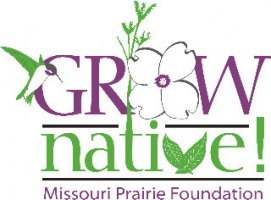Wild Ones has been featured in a New York Times article by Margaret Roach, highlighting our Native Garden Design program; you can read it via this gift article link.
Another New York Times article, also by Margaret Roach, follows Evan and Sarah (Weaner) Cooper, as they turn their lawn into a wildflower meadow, including how-to tips to not offend your neighbors.
Meet the ecologist who wants you to unleash the wild on your backyard
—————————————————————————————-
 Grow Native! is the native plant marketing and education program of the Missouri Prairie Foundation. Their website includes information on native plants, a landscaping guide, a buyers guide on where to buy native plants and seeds, and much more.
Grow Native! is the native plant marketing and education program of the Missouri Prairie Foundation. Their website includes information on native plants, a landscaping guide, a buyers guide on where to buy native plants and seeds, and much more.One of our favorite parts of the Grow Native! website are the Top 10 lists
—————————————————————————————-
Check out our chapter’s Facebook Page for shared articles and events
—————————————————————————————-
Chapter member Besa Schweitzer has a native plant gardening blog: Besa Grows Wild
—————————————————————————————-
The St. Louis Native Plant Swap Facebook Page is a great place to swap plants with other native plant lovers
—————————————————————————————-
The 2021 Partners for Native Landscaping spring guide contains lots of great information about many resources available to us in the greater St. Louis area
—————————————————————————————-
Gisele Baner’s Master Naturalist Capstone Project is a guide helping you to establish a herbicide-free native prairie flower garden from seed.
—————————————————————————————-
Native Landscaping Manual. A collaborative project between the Missouri Department of Conservation and Shaw Nature Reserve. Available free as PDF downloads:
- Chapter One: Reconstructing a Tall Grass Prairie
- Chapter Two: Rain Gardening and Storm-water Management
- Chapter Three: Control and Identification of Invasive Species
- Chapter Four: Landscaping with Native Plants, including recommendations on plants resistant to deer browsing
—————————————————————————————-
Eastern Illinois University has an online seedling identification database: Prairie Restoration: A Digital Aid Featuring Seeds, Seedlings, and Fruit with a plant list by species and a plant list by common name.
—————————————————————————————-
A StoryMap from Heather Holm about Pollen Specialist Native Bees
—————————————————————————————-
Missouri Department of Conservation offers tree, shrub and woody vine seedlings for order in the Fall, delivered the following spring
—————————————————————————————-
Deep Roots KC is a collective impact organization of multi-sector Partners. Together with their Partners, they work to increase native plant landscapes. The mission is to encourage the appreciation, conservation, and use of native plants in the heartland through educating, collaborating, and facilitating the planting of regenerative native landscapes that are essential for a healthy planet.
—————————————————————————————-
Videos:
- Hometown Habitat features renowned entomologist Dr. Douglas Tallamy, whose research, books and lectures on the use of non-native plants in landscaping, sound the alarm about habitat and species loss. All of us have the power to support habitat for wildlife and bring natural beauty to our patch of the earth.
- The Value of Having Nature in Our Yards Doug Tallamy, Professor, Entomology & Wildlife Ecology, University of Delaware, explains why providing native plants in your garden is an important food source for a healthy animal population. Tallamy discusses plant conservation scenarios in the tropics designed to provide food for endangered species.
- Creating Healthy, Biodiverse Neighborhood CorridorsDoug Tallamy, Professor, Entomology & Wildlife Ecology, University of Delaware, discusses the need to create biodiverse corridors or paths where wildlife and insects can safely move from one environment to another. These corridors could help species which are currently limited by roads and other man-made obstacles to connect with other populations of their species.
- Nature’s Best Hope Doug Tallamy’s keynote speech based on his new book. Nature’s Best Hope lays out the blueprint for us to reverse the decline and create sanctuaries for biodiversity in an easy, approachable way.
